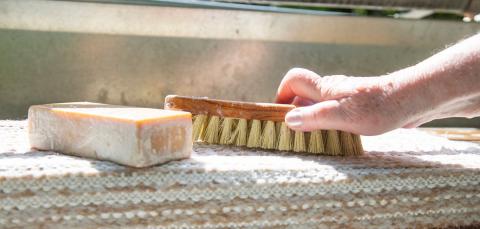Rug washing instructions

Use pine soap, which does not contain phosphates that cause eutrophication of the water. Make a light solution in a bucket or in the washing basin, as it is difficult to rinse the soap directly off the rugs. A small splash of the solution on stains is enough. Solid pine soap is best suited for washing rugs, as it lasts longer and is more environmentally friendly than liquid soap. Do not, however, rinse even pine soap directly into the waterways, as the resin acids in the soap are toxic to fish. You can also use vinegar to get rid of stains and brighten up the fabric’s colours.
We recommend washing rugs on a flat surface to avoid uneven wear. Always remember to brush rugs in the direction of the weave to let the brush get in between the threads. After washing one side of a rug, rinse it, brush the other side, and rinse it again. Rugs aren't often properly soaked until now. Washing rugs carefully pays off, otherwise built-up dirt in the rug will quickly rise back to the surface.
A traditional root brush may be too rough and break the surface of the weave, even if having a slightly fuzzy rug might not be such a bad thing. Use an arm brush for a better effect and to save your back. A pressure washer can also be helpful, as long as the pressure is not too high so as to loosen the weave.
Rinse the rug thoroughly to get all the soap and dirt out. A dry rug has to smell clean, not stuffy and soapy.
Let rugs dry in the freely in the air. Drying rugs on a line can leave a sharp crease, but what you can do is put a plastic tube on the line or hang them on a wooden rail to drip. A traditional, striped rug should always be put to dry with the stripes vertically, to not bleed the colours. Rugs will dry fastest on a warm and windy late spring or early summer. Autumn air may be too humid to let the rugs dry in good time. Do not use a rug until it is completely dry.